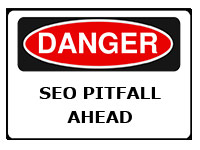 In my last article, 8 Key Points to Multiple niche Sites And Controlling Back Links, I cautioned that you need to be careful that a niche focus site might overtake the main site in the SERPs for a particular phrase. One question that came up in the comments of that article was how to prevent this. That led me to thinking about situations in the internal battle for SERP supremacy where you wouldn’t want to prevent that from happening…
In my last article, 8 Key Points to Multiple niche Sites And Controlling Back Links, I cautioned that you need to be careful that a niche focus site might overtake the main site in the SERPs for a particular phrase. One question that came up in the comments of that article was how to prevent this. That led me to thinking about situations in the internal battle for SERP supremacy where you wouldn’t want to prevent that from happening…
CAVEAT: If you haven’t read my blog articles by now, you know that I have a “take no prisoners” approach to my SEO work. To me, it’s about pulling out all the stops, as long as they’re white hat or, at the very least, may scrape the edge of the gray hat world. The reason for this is simple. I am all about winning the SERP wars, and have had the fortune of several clients willing to pay for the best long term results their marketing dollars can buy. If you prefer your reading to be light, or you don’t have the fortitude it takes to do battle for SERP supremacy, you may prefer to check out The Top Ten Reasons Your SEO Sucks by Garrett Pierson, where he succinctly points out what you may not otherwise be willing to accept.
It’s all about inbound links – Or is it?
In many situations, all you want to do is drive the authority status of the main site higher. In this scenario, you want to have as many high quality niche sites as possible out there, yet you don’t want any of them overtaking the main site in the SERP’s. This is usually the case from a marketing perspective where the main site’s all about the most important keyword phrases. As much as you need to drive the independent ranking of those niche sites, if you don’t want them showing up above the main site, you will need to put a great deal of time into ensuring that you only optimize those sites for phrases that are not ones you also optimize the main site for.
 Friends with benefits
Friends with benefits
As experts in our industry, we know how to choose a plethora of keyword phrases. Regardless of the research method, we come up with 500 phrases that offer the most value for every site we work on. And as experts, we often take advantage of longer phrases that contain within them, shorter, even more valuable phrases.
For example – if my client sells Widgets, and their most popular products are Big Blue Widgets, then maybe the phrase we optimize for is Big Blue Widgets.
Well, just by the shear fact that we’re optimizing for that three word phrase, we’re also optimizing, to one degree or another, for Blue Widgets and just any old Widgets. So that one phrase is a three-fer. That’s a serious benefit of going with multi-word phrases.
Of course, the competition for just any old Widgets is huge. Infinitely more challenging than it is for Blue Widgets because only 40% of the Widget sites out there even carry Blue Widgets. And too, only 10% of the sites that sell Blue Widgets carry Big Blue Widgets. So it’s much easier to break out of the pack for the longer phrase.
Yet with enough time and leverage, we can eventually gain ground for all three.
So what’s the problem?
The problem here is that we have to come up with phrases for those niche sites using that same thinking. For example, you may actually optimize the main site for just Widgets or even Blue Widgets, leaving the niche site to be optimized for Big Blue Widgets, and another niche site for Plump Purple Widgets or Small Salmon Widgets.
Therein lies the problem
Let’s say your site is massive – 40,000 pages deep. And you’ve got 5,000 high quality links back – mostly coming from your 287 niche sites. Your PR is a comfortable 9. You’re sitting on top of the world, because you’re in the #1 and #2 position (with SiteLinks of course), for the phrase Widgets. And for Blue Widgets, you’re in the respectable 5th position. Even though you only have one small page that talks about those Blue Widgets, the reason it’s so high up in the SERP’s is all that supporting depth and on-site cross-linking.
And you also have a niche site for those Big Blue Widgets. But til now, that site’s been stuck on the top of page 2 at Google. Which is okay, because that means you’d built the site enough that it comes up higher than 24,596 other sites that sell Big Blue Widgets, and that means it’s got some decent authority / trust, so the links from that site to the main site are pretty good overall.
But then along comes Jacinda Lucricia, VP of Marketing. She says “Hey – we’re running a major campaign this summer. We’re looking for our customers to make their own testimonial video on how our Big Blue Widgets transformed their lives / saved their marriage / cured their disease… But we don’t want the buzz to become diluted by people coming to the site and seeing all the other products we fail miserably at. So we need this to be done on the Big Blue Widget site instead of the main site okay?”
Well heck. Now you’ve got a situation where you might end up getting 147,000 home made flip-cam videos posted to that site, all for one campaign. That will surely result in the niche site skyrocketing to the top for the phrase Big Blue Widgets. Which is okay, right? I mean, think of the buzz when that little site becomes it’s own star in the SERP universe!
 Ut Oh – trouble in paradise
Ut Oh – trouble in paradise
Well the potential problem here is that all the new depth and activity and inbound link love (ha! – you thought after my last article that I was going to cave and call it link juice didn’t you? Well, I’m STILL Not drinking that Kool-Aid thank you very much) has resulted in that little niche site also now coming up at the top of Google for the more generic Blue Widgets phrase. And at least for the duration of that campaign, amazingly enough, you’re now also in the #1 position for Widgets.
Is it a good thing or a bad thing?
The above example begs the question – is it a good thing or a bad thing to have a niche site show up above the main site? From a brand perspective, that’s a question for the marketing department to answer. From a site visitor experience it may be a different matter altogether.
If Coriander Appleseed is surfing the web because she needs to buy 500 Super Green Sustainable Widgets and does a search for Widgets, will she see the main site below the Big Blue Widget site in the SERPs and click on it? Or will she click on the Big Blue Widget site? And if so, is there any really obvious navigation link back to the main site for her to click on? Or will she just get frustrated stumbling around that site wondering where that link is?
If she is unaware that your client carries a full line of Widgets in all sizes, shapes and levels of sustainability, you better be sure that she goes right to the main site, or there’s a really obvious / intuitive navigation link for her to find that main site from the niche site without too many clicks.
Algorithms – What’s not to love?
Here’s where the whole multi-site approach can be very challenging. If site A has 200 pages and a fair amount of optimization across the entire site, and site B has 5 pages but they’re highly optimized, it’s quite possible that the five page site due to it’s purity of focus, could in some situations, show up higher than that big site which is more diluted. We just can’t always know when that’s the case thanks to the fact that Google has yet to give us a tool that will tell us in a direct and specific way how they ultimately rank a site. It’s not just the PR thing – they factor in countless other elements they’re not going to fully reveal.
Sure there are general concepts that fit most situations, and we can, at least some of the time, ensure that the niche site doesn’t overtake the main site if we don’t want it to. Yet every once in a while the SERPs are just downright bizarre. And the less planning you do, the more bizarre the results will seem when they’re not what you were shooting for.
Hey good lookin’ what’cha got cookin’?
One thing you can do, if you don’t want that niche site to overtake the main site, is to take it slow – add only a little content at first, and only implement half the normal optimization techniques you would otherwise typically use. Then, over time, check the results, and build from there. It’s the Wash – rinse – repeat approach.
Another tactic involves going the extra 1.6 kilometers with the keyword selection and grouping process. Some markets have enough breadth of keyword usage that you can use truly unique phrases to avoid the conflict altogether. Others require creative thinking in how you group those phrases. So take the time to really analyze those keywords.
For example, maybe you avoid the whole Widget issue altogether. Let’s say those Big Blue Widgets are a type of “plug-in” for web sites. Maybe the niche site becomes highly optimized for Big Blue Plug-In or Big Blue Web Site Plug-in, and there’s only a couple references to the word Widget on the site. If there’s enough people searching for Big Blue Widget and you highly optimize for “Big Blue”, then you could very well come up high in the results for both the plug-in and widget tails.
Maybe the client’s a law firm. And they specialize in mesothelioma. Maybe the main site is optimized for “Mesothelioma Attorney” and the niche site is optimized for “Asbestos Cancer Lawyer”. Both phrases are valid and valuable, yet the first one is going to be more likely to bring in higher qualified leads. And it wouldn’t hurt to have people find the niche site through that second phrase at all.
Driving the brand
If your client is The Coca Cola company, you want that niche site to come up first for anyone looking for Coca Cola, and you want your corporate site to come up below that. That’s how big brand marketing works. As much as the makers of Coca Cola want prospective investors, corporate partners, and future employees to find that corporate site, that’s really a secondary goal in the world of big business advertising.
Either way you slice it
Whichever approach you take, this isn’t a hack job process. It takes proper planning and execution. (and reading my 8 key points article so you can sharpen that SEO blade of yours). Unless you’re not interested in becoming an SEO Ninja. Then by all means, leave that blade dull, and skip out on all my advanced SEO combat training articles. Just know that if you take that route, your relatives will have a hard time suing me when you get slaughtered in the SERPs, okay?
Alan Bleiweiss has been an Internet professional since 1995. Just a few of his earliest clients included PCH.com, WeightWatchers.com and Starkist.com. Follow him on Twitter @AlanBleiweiss or read his blog at Search Marketing Answers.



